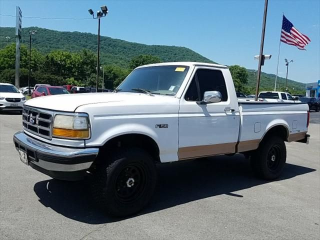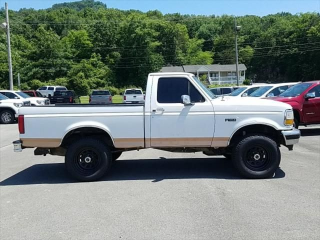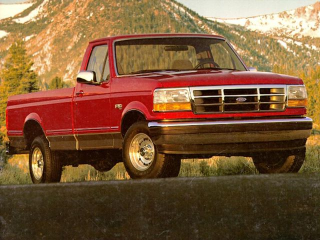The Good
The 1995 Ford F-150 offers robust performance from its range of capable engines and a design that's both classic and functional. Its renowned reliability and relatively low ownership costs make it a strong practical choice. Emotionally, it evokes nostalgia, representing a durable workhorse and a symbol of American craftsmanship, delivering excellent long-term value and an authentic truck experience.
The Bad
Potential buyers should watch out for common weaknesses such as body and frame rust, especially in salt-belt regions. Electrical issues, particularly involving the fuel pump selector switch and general wiring, are also frequent. Additionally, the E4OD automatic transmission can be prone to failure, and steering/suspension components like the Twin I-Beam bushings often require attention due to wear.
1995 Ford F-150: Quick Overview
- Engine Options:
- 4.9L (300 cu in) "Big Six" Inline-6: Renowned for its durability and torque.
- 5.0L (302 cu in) "Windsor" V8: A balanced option for power and everyday driving.
- 5.8L (351 cu in) "Windsor" V8: The most powerful factory engine for the F-150. - Horsepower:
- 4.9L I6: Approximately 150-170 hp.
- 5.0L V8: Approximately 195-205 hp.
- 5.8L V8: Approximately 205-210 hp. - Fuel Economy (EPA Estimates, highly variable by configuration/driving):
- 4.9L I6: Around 13-16 MPG city / 17-20 MPG highway.
- 5.0L V8: Around 12-15 MPG city / 16-19 MPG highway.
- 5.8L V8: Around 11-14 MPG city / 15-18 MPG highway. - 0-60 Times:
- These trucks were not designed for speed. Estimates typically range from 9.5 to 12 seconds, depending heavily on engine, transmission, and drivetrain (2WD vs. 4WD). - Towing Capacity:
- Varies significantly by engine, transmission, axle ratio, and configuration (Regular Cab, SuperCab, 2WD, 4WD). Generally, the 1995 F-150 could tow from approximately 3,500 lbs up to around 7,500 lbs with the appropriate setup and 5.8L V8. - Trim-Level Features:
- XL: The base work truck. Standard features were sparse, often including manual windows and locks, vinyl seats, and an AM/FM radio. Intended for utility.
- XLT: A popular mid-range trim. Added cloth seats, power windows and locks, air conditioning, cruise control, a tilt steering wheel, upgraded AM/FM cassette stereo, chrome bumpers, and more appealing exterior trim.
- Lariat: Offered more luxury. Included premium cloth or optional leather seating, a more comprehensive gauge cluster, unique exterior badging, and often more chrome or two-tone paint options. Many XLT features were standard here.
- Eddie Bauer: The top-tier lifestyle trim. Featured unique two-tone paint schemes, special Eddie Bauer badging, premium cloth interior, often with distinct trim accents, and nearly all available comfort and convenience options as standard.
1995 Ford F-150 Specifications
Vehicle Information
| Year | 1995 |
| Make | Ford |
| Model | F-150 |
| Trim | - |
| Style | - |
| Type | Truck |
| Category | Standard Pickup Truck |
Manufacturing Details
| Made In | Mexico |
| Manufacturing City | LOUISVILLE |
Dimensions
| Doors | 2-Door |
| Curb Weight | 3886 pounds |
| Gross Vehicle Weight Rating | 5000 pounds |
| Overall Height | - |
| Overall Length | - |
| Overall Width | - |
| Wheelbase Length | - |
| Standard Seating | - |
Engine & Performance
| Engine | N14 |
| Engine Size | 4.9L |
| Engine Cylinders | 6 |
| Transmission | 4-Speed Automatic |
| Transmission Type | Automatic |
| Transmission Speeds | 4-Speed |
| Drivetrain | Rear-Wheel Drive |
Additional Features
| Anti-Brake System | - |
| Steering Type | - |
Pricing
| Manufacturer Suggested Retail Price (MSRP) | - |
| Invoice Price | - |
| Delivery Charges | - |
Vehicle History Report
Specifications
History
Events
History Check
Check
Check
Check
Check
Listings
Recalls
Check
Analysis
What Problems Does the 1995 Ford F-150 Have?
Transmission issues are another significant concern, particularly with the E4OD automatic transmission. This electronically controlled unit can be prone to premature failure, manifesting as harsh shifts, slipping, or complete loss of gears. The mechanically simpler AOD and M5OD manual transmissions tend to be more reliable.
The dual fuel tank system can lead to problems, specifically with the fuel pump selector valve failing or the in-tank fuel pumps themselves. This can cause fuel to cross over between tanks, inaccurate fuel gauge readings, or complete fuel delivery failure.
Electrical problems are also common, ranging from minor issues like power window/lock failures to more critical ones involving the ignition system or the notoriously problematic cruise control deactivation switch, which was subject to multiple recalls. The wiring harnesses can also degrade over time, leading to various intermittent issues.
Speaking of recalls, the 1995 F-150 was part of a widespread recall campaign concerning the speed control deactivation switch, which, if faulty, could overheat and cause fires even when the engine was off. Owners should ensure any such recall work has been performed. Other recalls have covered issues like seat belt components. The Twin I-Beam front suspension, while durable, is known for eating through bushings and ball joints, leading to steering looseness and uneven tire wear if not regularly maintained.
Lastly, the age of components means items like power steering pumps, alternators, water pumps, and brake components (especially ABS sensors and modules) are common failure points. While most issues are repairable due to readily available parts, extensive rust or major transmission failure can make repairs uneconomical.
How long will the 1995 Ford F-150 last?
Its long-term durability is largely attributed to its strong, simple engine designs and heavy-duty frame. However, weaknesses emerge over time, predominantly severe rust on the body and frame, which can become structurally compromising. Interiors also show wear and tear, with cracked dashboards, worn seats, and failing headliners being typical. The E4OD automatic transmission remains a long-term reliability concern, and suspension components require periodic replacement to maintain ride quality and safety. Consistent fluid changes, rust prevention, and proactive maintenance are key to extending its lifespan.
What Technology & Safety Features are Included?
Built-in Tech & Entertainment: Standard equipment on lower trims (XL) was basic, typically an AM/FM radio with two speakers. Higher trims (XLT, Lariat, Eddie Bauer) offered upgraded AM/FM cassette stereos, often with four speakers, and some even had an optional single-disc CD player. Power windows, power door locks, and cruise control were desirable optional features, often standard on XLT and above. Air conditioning was also a common and welcome option, providing essential comfort. The instrumentation was analog, clear, and functional, with an odometer and basic warning lights.
Driver-Assistance Features: True driver-assistance features as we know them today (e.g., lane keeping assist, blind-spot monitoring) were non-existent. The most advanced 'assistance' would have been power steering and optional cruise control, which helped reduce driver fatigue on long journeys.
Safety Features: Safety equipment was basic but met contemporary standards. A driver-side airbag became standard from 1994, offering front impact protection for the driver. Anti-lock brakes (ABS) were typically standard for the rear wheels, with some configurations offering four-wheel ABS as an option, improving braking stability. Three-point lap/shoulder belts were provided for outboard occupants, with a lap belt for the center passenger. Side airbags, electronic stability control, and traction control were still years away from becoming mainstream.
Crash-Test Ratings: Official, comprehensive crash-test ratings from organizations like NHTSA or IIHS in the manner they are conducted today are not readily available or comparable for a 1995 vehicle. Crash tests performed in the 1990s focused more on frontal impacts, and results are difficult to interpret against modern safety benchmarks. Generally, trucks from this era provided significant mass protection but lacked the sophisticated crumple zones and advanced restraint systems found in contemporary vehicles. The F-150, being a large body-on-frame truck, offered a degree of inherent robustness but had limited advanced safety features.
What Colors Options are Available?
1995 Ford F-150 Prices and Market Value
Today, current used market prices are highly variable, ranging from as little as $2,000 - $5,000 for a high-mileage work truck with some issues, to $10,000 - $20,000+ for exceptionally clean, low-mileage, or specific enthusiast-desired models. Depreciation was significant during its first decade, typical for a mass-produced vehicle. However, as it has aged into classic territory, depreciation has largely ceased, and well-preserved examples are now appreciating in value.
Factors affecting resale value include overall condition (especially rust), mileage, engine type (4.9L I6 and 5.8L V8 often command a premium), 4x4 capability, transmission type (manuals can be desirable), and trim level (XLT, Lariat, Eddie Bauer often sell higher). A complete service history and original features also enhance value.
1995 Ford F-150 Cost of Ownership
1995 Ford F-150 Fuel Efficiency
1995 Ford F-150 Safety Rating
NHTSA
IIHS
1995 Ford F-150 Insurance
reasonable repair costs.
How Does the 1995 Ford F-150 Compare to Other Truck?
In terms of Performance, all three offered a range of V6 and V8 engines. The F-150's 4.9L I6 was lauded for its longevity and torque, while its 5.0L and 5.8L V8s were competent. The Chevrolet C/K 1500 offered its robust 4.3L V6 and various versions of the small-block V8 (5.0L, 5.7L), often feeling slightly more refined. The Dodge Ram 1500, particularly with its powerful 5.2L and 5.9L Magnum V8s, often had an edge in raw power, appealing to those who prioritized grunt.
Regarding Features, all were fairly comparable for the era, offering similar trim levels from basic work trucks to more appointed family haulers. Power windows, locks, cruise control, and air conditioning were common options across the board. The F-150's interior was functional, while the C/K 1500 often felt a bit more car-like. The Ram 1500 stood out with its bold, "big rig" exterior styling that influenced truck design for years.
Reliability is a strong suit for all three, but each has its quirks. The F-150 is famed for its I6 engine and robust frame but can suffer from E4OD transmission issues and rust. The C/K 1500 is also known for durability but can have issues with intake manifold gaskets and some electrical components. The Ram 1500's Magnum V8s are strong, but plenum gasket issues are common. Overall, the F-150 often holds a slight edge in overall perceived mechanical longevity if well-maintained.
Price when new was competitive among the three. In the current used market, prices are also similar for comparable condition and configuration, though pristine examples of any of these '90s trucks can fetch premiums as nostalgia grows.
Alternatives:
- Chevrolet C/K 1500 (1988-1998): A very similar alternative, often praised for its ride comfort thanks to its independent front suspension (vs. F-150's Twin I-Beam). Parts are equally abundant.
- Dodge Ram 1500 (1994-2001): For those prioritizing bolder styling and powerful V8 options, the Ram offers a distinct personality. Watch for plenum gasket issues.
- GMC Sierra 1500 (same as Chevrolet C/K 1500): Offers the same advantages as the Chevrolet with slightly different branding/trim options.
Final Verdict: Is the 1995 Ford F-150 a Good Truck?
It is absolutely worth buying, but only under specific conditions: acquire it as a used vehicle, as new ones are obviously unavailable. Prioritize examples with minimal rust on the frame and body, especially in critical areas. A thorough pre-purchase inspection is crucial, focusing on the engine, transmission (particularly E4OD), and steering/suspension components. Opt for a 4.9L I6 for maximum longevity or a 5.8L V8 for more power. XLT or Lariat trims offer a good balance of features and comfort. Avoid neglected examples unless you're prepared for significant restoration costs. This truck is not for those seeking modern safety features, fuel efficiency, or a "set-it-and-forget-it" ownership experience without regular attention.



